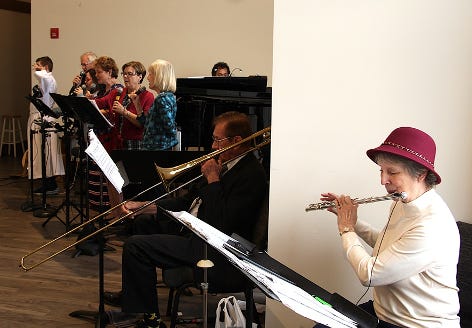“Rebutting Body Shame” first appeared in The Sage Forum’s January 2025 Newsletter.
In the late 70s, my mother-in-law’s younger sister entered a women’s magazine make-over contest. Pat was in her mid-forties, a Harvard JD, teaching law at a prestigious university. “I wanted to see if there was something I could do to look better,” she said with her characteristic spunk. One catch: the magazine required contestants not to cut or color their hair for three months before the make-over.
Regarding the ‘Before’ picture, the magazine writers made much of how Pat’s unkempt hair and grey roots aged her, without disclosing the three-month, no cut or color requirement. They also didn’t mention that the hairdresser gave her the same cut and color she’d had when she sent her picture in for the contest, or the two-hour makeup session before the ‘After’ photograph. “With all that makeup on, I felt like my face would break when I smiled for the camera,” Pat said. She decided her current hair and makeup routine would suffice.
Our physical bodies are amazing creations. Skin—soft, warm, touchable—conveying the essence of a God eager to relate to us in love. Bones, a necessary frame; blood, our life’s source: every cell in every body lives at the mercy of blood. Breath, the spirit that allows us to survive this alien world. Muscles to put us in motion; and our brains, the body’s CEO.
“The entire mental process comes down to the brain’s cells spitting chemicals at each other across synapses. Its complexity defies description, with the total number of connections far exceeding the number of galaxies in the universe.,” wrote Dr. Paul Brand and Philip Yancey in their modern classic, Fearfully and Wonderfully: The Marvel of Bearing God’s Image.
God created our wondrous bodies and named them good, so why are we often ashamed of our bodily imperfections?
I was born with a clubfoot, which was surgically repaired the summer I turned twelve. Because the foot was still an inch shorter than the other, for years thereafter, I stuffed tissue into the toe of that shoe so I could wear strapless heels like everyone else, a practice which curled, bruised, and blistered my toes. The price of beauty, I told myself. But then in mid-life I asked myself: Why am I torturing my foot? Why am I risking infection? Why do I hate this gift that’s taught me so much— patience, perseverance, problem solving—this precious foot I’m charged to take care of? Since then, I’ve only worn comfortable shoes that tie, zip, or buckle and don’t worry about limping when I’m tired. Most of us do.
As we enter the second-half of life, many of us hope we’re over the shame of not “conquering” our bodies. After all, we’ve aged out of the obsessed youth-beauty market—thank goodness—and are mature enough to see what an impossible standard it is. Yet, according to Jess Connolly in Breaking Free from Body Shame: Dare to Reclaim What God Has Named Good.“…we’re still out here, all of us, overly exposed to a light that is not warm with grace, but rather judging what is not ‘right’ about us…” Rather than seeing ourselves from God’s perspective, we judge our bodies and the bodies of others; we harm ourselves and others with those judgements; we fall victim to harassment and shame.
Are we loving our bodies or trying to make them into something we can love? Connolly asks. “We’re told our bodies are projects to work on… We’re told our bodies are reflections of our righteousness… We’re told our bodies are trophies… We’re told our bodies are bad…We’re told these messages overtly, subtly, indirectly.”
Clearly, body image is a deeply spiritual issue, and we need a better mindset than the one we receive from the world around us–one that is grounded intentionally in Biblical and Gospel truths.
Though there is no physical description of Jesus, we can surmise from Isaiah 53:2 that He was no ideal physical specimen: “For he grew up before him like a young plant, and like a root out of dry ground; he had no form or majesty that we should look at him, and no beauty that we should desire him.”
Instead of poking, prodding, and shaming ourselves in pursuit of fame, fortune, and beauty, we should express the image He modeled: humility, servanthood, and love, as in Paul’s letter to the Philippians 2:5: “In your relationships with one another, have the same mindset as Christ Jesus.” Throughout the Bible, we see that God’s Spirit shines most brightly through the frailty of the weak; and discover that Christ kept his scars as an eternal remembrance of his time on earth–and each one of us.
As we age, we accumulate scars and need a little—sometimes a lot—of assistance in keeping our bodies in working order. The good news is that as we mature spiritually, we are usually more able to view the image of our bodies from an eternal perspective. We recognize that maintaining our health—our skin, bones, blood, breath, muscles, and brains—allows us to be of service to others while we serve God until he returns.
Christ has no body now but yours. No hands, no feet on earth but yours. Yours are the eyes through which he looks compassion on this world. Yours are the feet with which he walks to do good. Yours are the hands through which be blesses all the word. Yours are the hands, yours are the feet, yours are the eyes, you are his body. Christ has no body now on earth but yours. –St. Theresa of Avila

A final note. Last year, my hairdresser found a spot on the crown of my head—diagnosed as a malignant melanoma. My hairdresser, dermatologist, and surgeon saved my life. While the incision healed, I wore hats in public to protect the wound, as here, playing with the Worship Team at church.
We Sages worship Him with bodies made by God in the image of God, and put on our hats to serve others. For His glory.
Without shame.



0 Comments